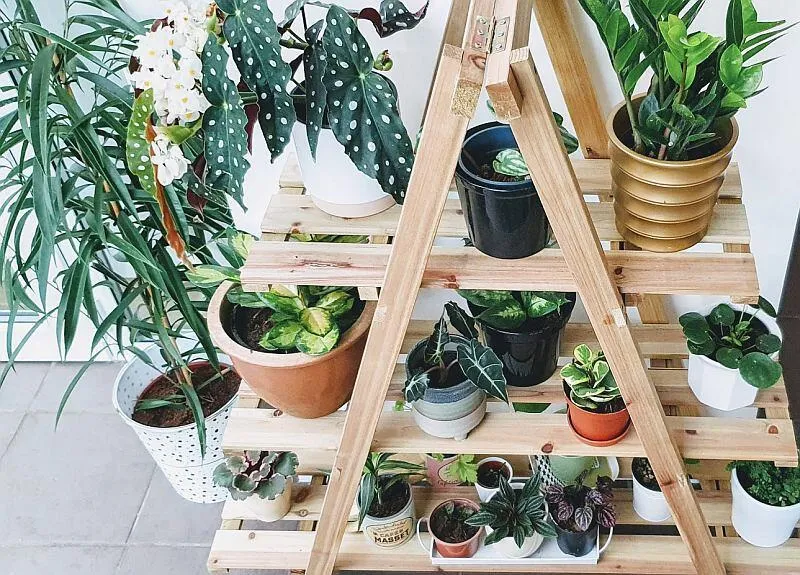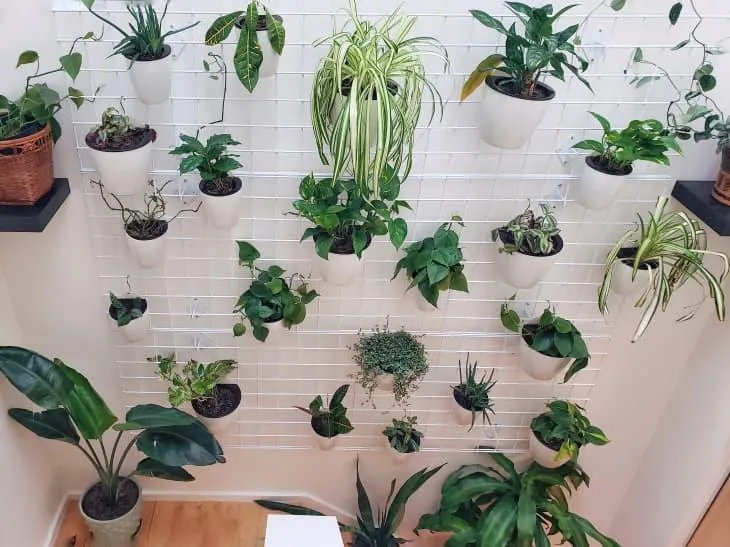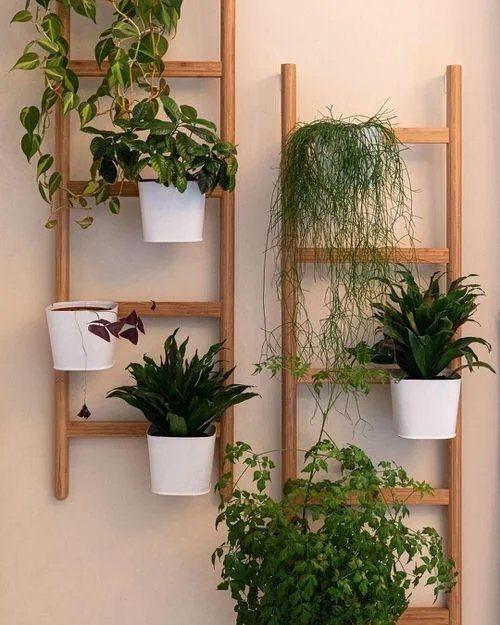All You Need to Know About Hanging House Plants
If you’re searching for “hanging house plants”, chances are you’re looking to add some greenery above your head. In this article, I’ll cover all the basics of growing plants that hang from ceilings and shelves.
Best Plants for Hanging Baskets
Here are some of the most popular hanging house plants and their care requirements:
- Pothos – One of the lowest maintenance options. Pothos thrive in medium to low light and don’t need much water. They come in various varieties with different leaf patterns.
- Philodendron – Another durable vine plant. Philodendrons prefer bright, indirect light and moderate watering. They come in green or variegated forms.
- English Ivy – This classic climber has small dark green leaves. Provide it partial to full shade and keep the soil slightly moist.
- Spider Plants – With their long grass-like leaves and little plantlets that form on long shoots, spider plants are charming hangers. Water when the top inch of soil dries out.
- Swedish Ivy – If you want full bushy coverage, Swedish Ivy has your back. It thrives in medium to low light with moderate watering every 7-10 days.
Those are some of the heartiest and low-effort hanging plants. Less demanding varieties let you keep plants even if you’re forgetful with watering. From my experience, pothos and philodendrons tolerate more drying out than others.
Choosing the Right Pot
A hanging basket or pot with drainage holes is essential to prevent root rot. The container should be large enough that the plant’s roots won’t be cramped but not so big that most of the soil stays moist. Terracotta and plastic are good options that wick away excess moisture.
Consider getting a hanging basket with an attached watering hook or tray to catch drips. Otherwise, place a plate or saucer under the pot before watering. I often hang different plants together in mesh or woven baskets for a lush, full look.
Where to Hang Plants
Nearly any spot can work for a hanging plant as long as it receives the proper light. Common choices are:

- Above windows to take advantage of natural light without blocking views
- From ceilings in entryways, kitchens, living rooms, or offices
- On shower rods for a tropical bathroom vibe
- Outdoor patios can support hanging baskets too if you choose tougher varieties
However, be mindful of drafts from air vents, direct sun through south-facing windows, or spots near doorways with steady foot traffic – these can dry plants out faster. The ideal microclimate depends on each plant’s preferences.
Watering Hanging Plants
Underwatering is more common than overwatering for hanging planters. Stick your finger an inch into the soil and water thoroughly when the top layer feels dry. Reservoir pots or self-watering systems can help ensure hanging plants stay hydrated between waterings.
Misting the leaves daily provides some moisture but isn’t a substitute for real watering. Some growers hang planters from macrame hangers or rope that allows lowering the whole pot for easy bottom watering too.
Be cautious of mineral deposits left behind from hard tap water. Try using rainwater, distilled water, or filtered water for finicky varieties. Empty any standing water from saucers below after 30 minutes.
Fertilizing and Growing Hanging Plants
Most hanging house plants appreciate an all-purpose liquid fertilizer diluted to half or quarter strength every few months during their growing season. Apply it when watering and avoid getting fertilizer on the leaves, which can burn them.
Signs a hanging plant needs food include yellowing lower leaves, slow growth, or leggy vines. Boost the nutrients for vigorous vines or add fertilizer even less frequently for plants like pothos that seem fine without much care.

Prune any dead or diseased parts as needed. Snip off leggy vines or stems to encourage bushier growth. Many varieties will root new plants where leaf nodes touch the soil or a moist surface. You can start new hanging planters from cuttings!
Dealing with Pests
Most common houseplant pests like spider mites, scale, or mealy bugs can plague hanging plants too. Check leaves regularly for any signs of tiny crawling bugs, fuzzy patches, or sooty mold developing. Isolate and quarantine infected plants immediately.
Spot treat with neem oil, insecticidal soap, or bio pesticides following label directions. Be diligent until infestations are fully eradicated. As a last resort, discard plants that cannot recover. Prevention through monitoring and cleaning up fallen leaves/debris works best.
Overwintering tender Plants Indoors
Come fall, relocate potted hanging plants you want to bring back inside before nighttime temperatures drop below 50 degrees F. Put them in a spot with bright, indirect natural light if possible.
Water only when the top inch of soil becomes dry. Consider reducing fertilizer during their dormancy period until temperatures warm up in spring. Removing yellow or dead growth keeps plants looking tidy over winter.
With the right care, hanging plants can add vertical color and greenery indoors year-round. Let me know if you have any other questions! From planting and watering to dealing with pests, this article covered all the basics for growing hanging house plants successfully.

Factors to Consider When Choosing Hanging Houseplants
| Plant | Light Needs | Water Needs | Height |
| Pothos | Low to bright indirect light | Allow soil to dry between waterings | Up to 6 feet |
| Philodendron | Low to medium light | Water when top inch of soil is dry | Up to 10 feet |
| Spider Plant | Bright indirect light | Allow soil to dry between waterings | Up to 3 feet |
| English Ivy | Medium to bright indirect light | Water when top inch of soil is dry | Up to 20 feet |
| Wandering Jew | Bright indirect light | Allow top inch of soil to dry | Up to 2 feet |
FAQ
-
What is the best way to water a hanging plant?
Basically, you’ll want to water hanging plants by taking them down and watering them from the bottom. This helps prevent overwatering and allows the water to reach the roots. You can also use a watering can with a long spout to reach the plants from above.
-
How often should I water hanging baskets?
It depends on different factors like the size of the plant, type of plant, weather conditions. As a general rule, hanging baskets may need water every day or every other day during hot/sunny weather. Maybe cut back to once or twice a week in cooler months. The soil should dry out somewhat in between waterings. Feel the soil and water when the top inch gets dry.
-
What’s the best type of soil for hanging plants?
Most experts agree that a good soil specifically made for containers works well for hanging baskets. These soils tend to be well-draining to prevent overwatering issues. You could even mix in some perlite or vermiculite to the container soil for extra drainage. On the other hand, regular garden soil may pack down and hold too much moisture.
-
How do I keep the soil from falling out of hanging baskets?
An easy solution is to line the hanging basket with mesh or fabric and secure it with ties or hot glue before adding the soil. You can purchase pre-lined baskets or line them yourself with nylons, mesh, or landscaping fabric. Plastic liners also work well. Despite lining it, the soil may still settle over time. Gently fluff it with a fork occasionally to maintain the shape.
-
What’s the best way to fertilize hanging plants?
You’ll want to fertilize hanging baskets throughout the growing season, perhaps every couple weeks. Water soluble fertilizers are quite convenient for hanging plants. Just follow the package instructions and mix it into the watering can. You could also use slow release fertilizer balls or spikes that slowly feed the plants for months. But is it worth it? The fertilizer may kind of wash away in rain.
How long will a hanging basket last?
If cared for properly, many hanging baskets can look great for a few months or even the whole summer. It really depends on the plant varieties used and your climate. Ask any gardening experts and they’ll say baskets tend to fade faster towards the end of summer. Give them fertilizer and lots of sun or shade if needed. Things may look less than amazing by late fall.

